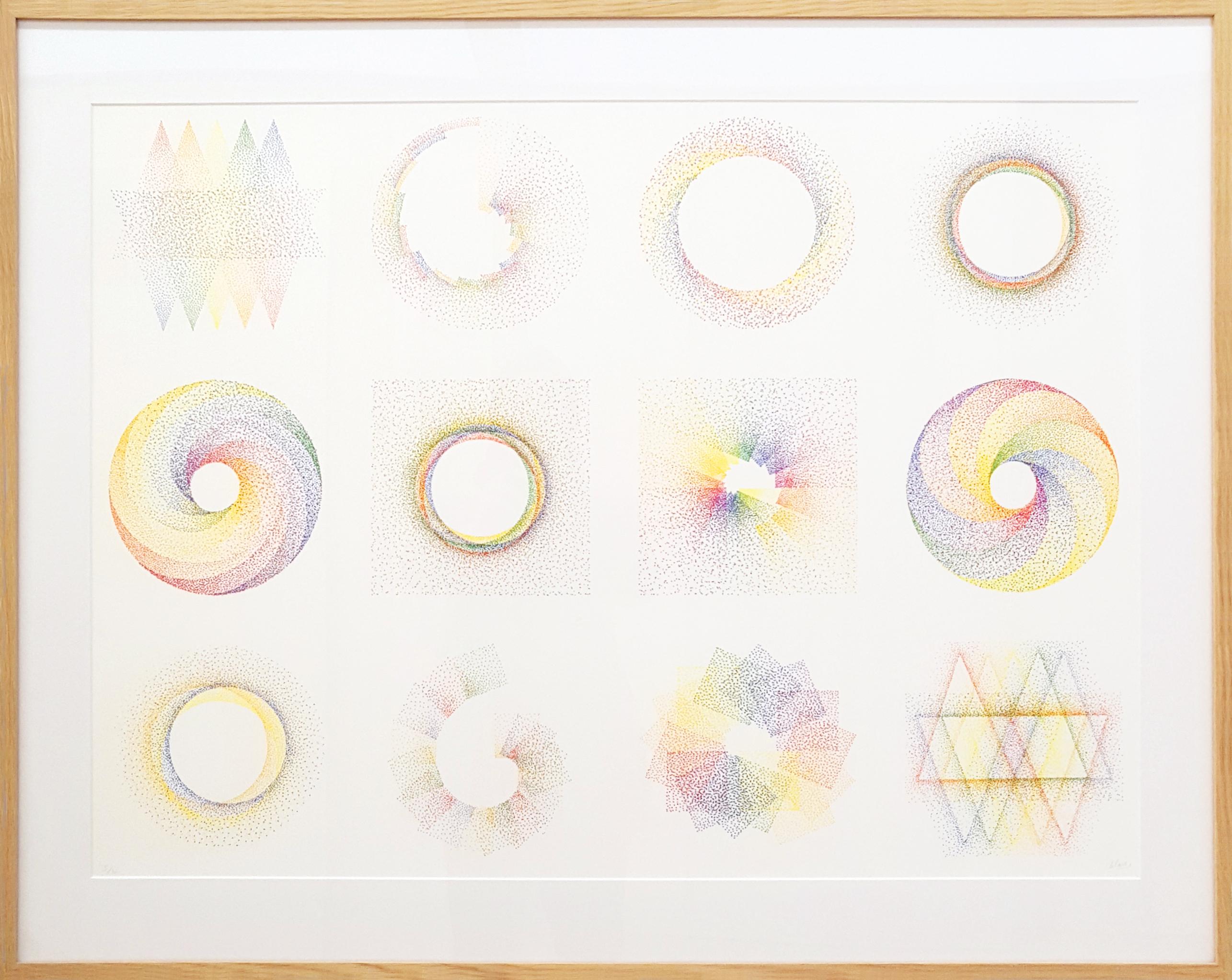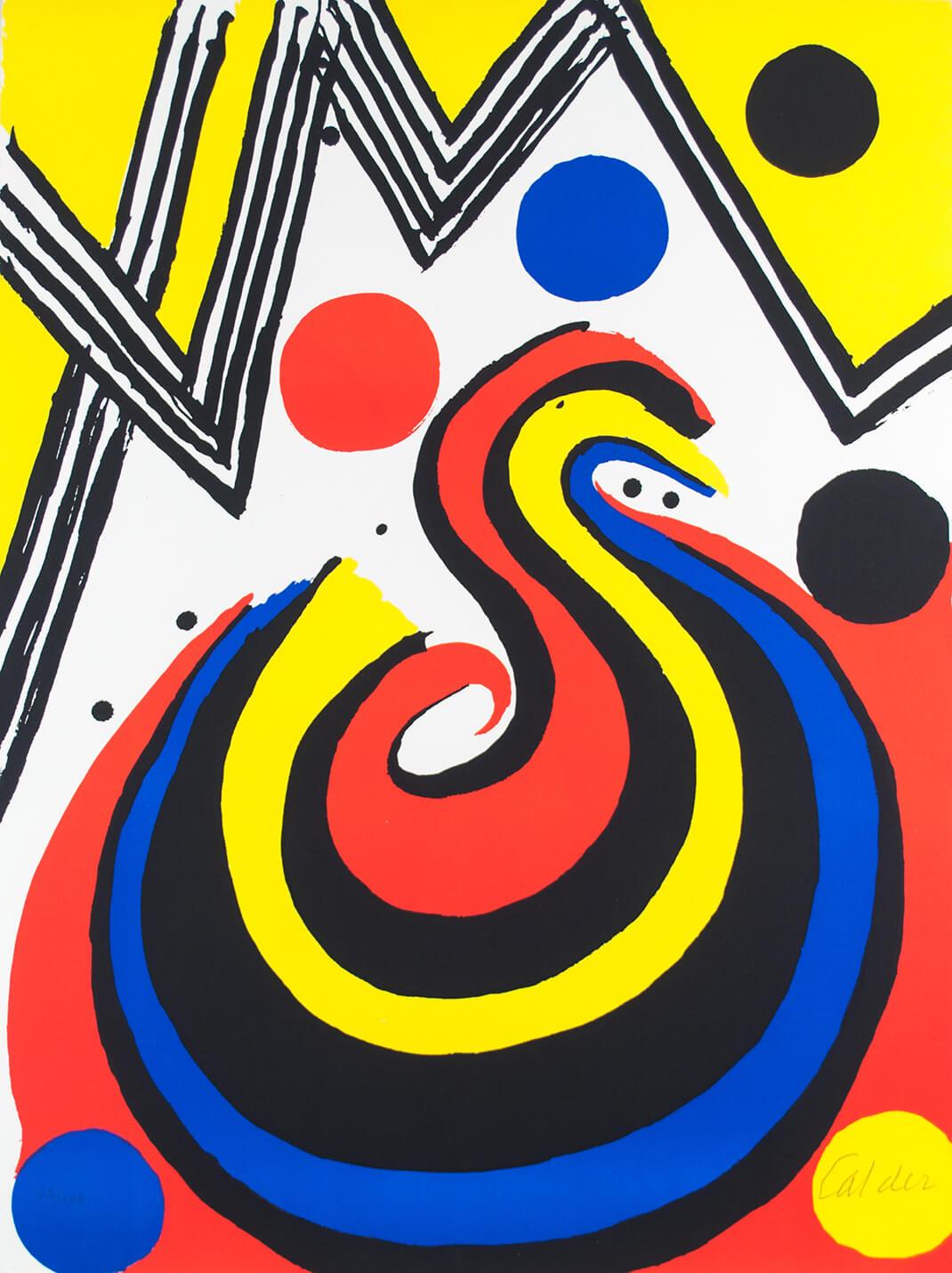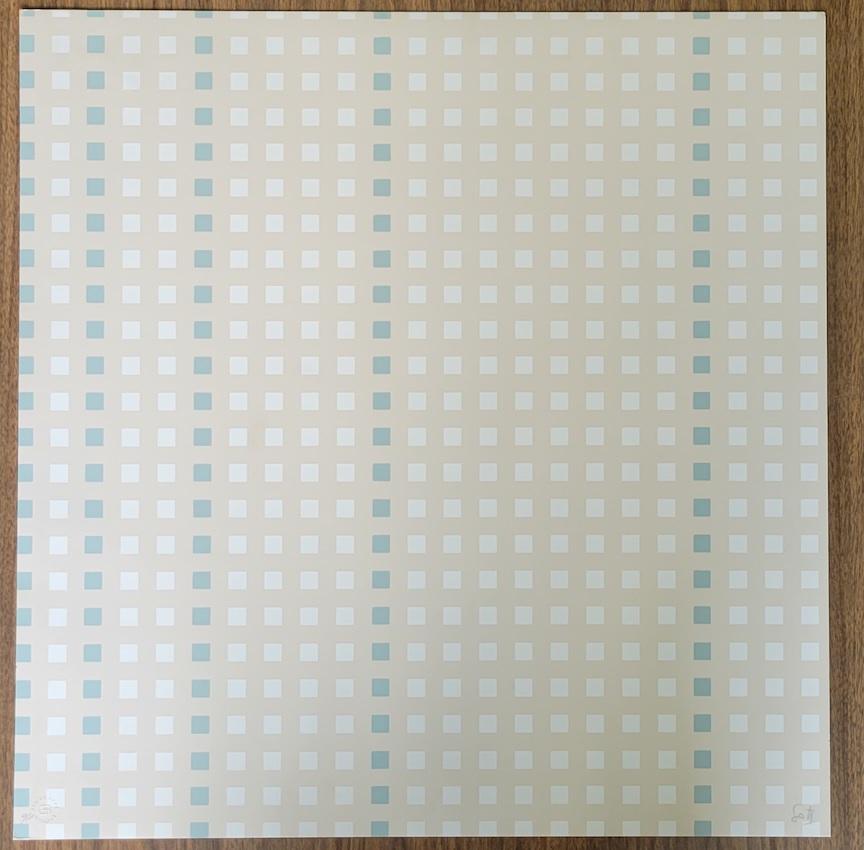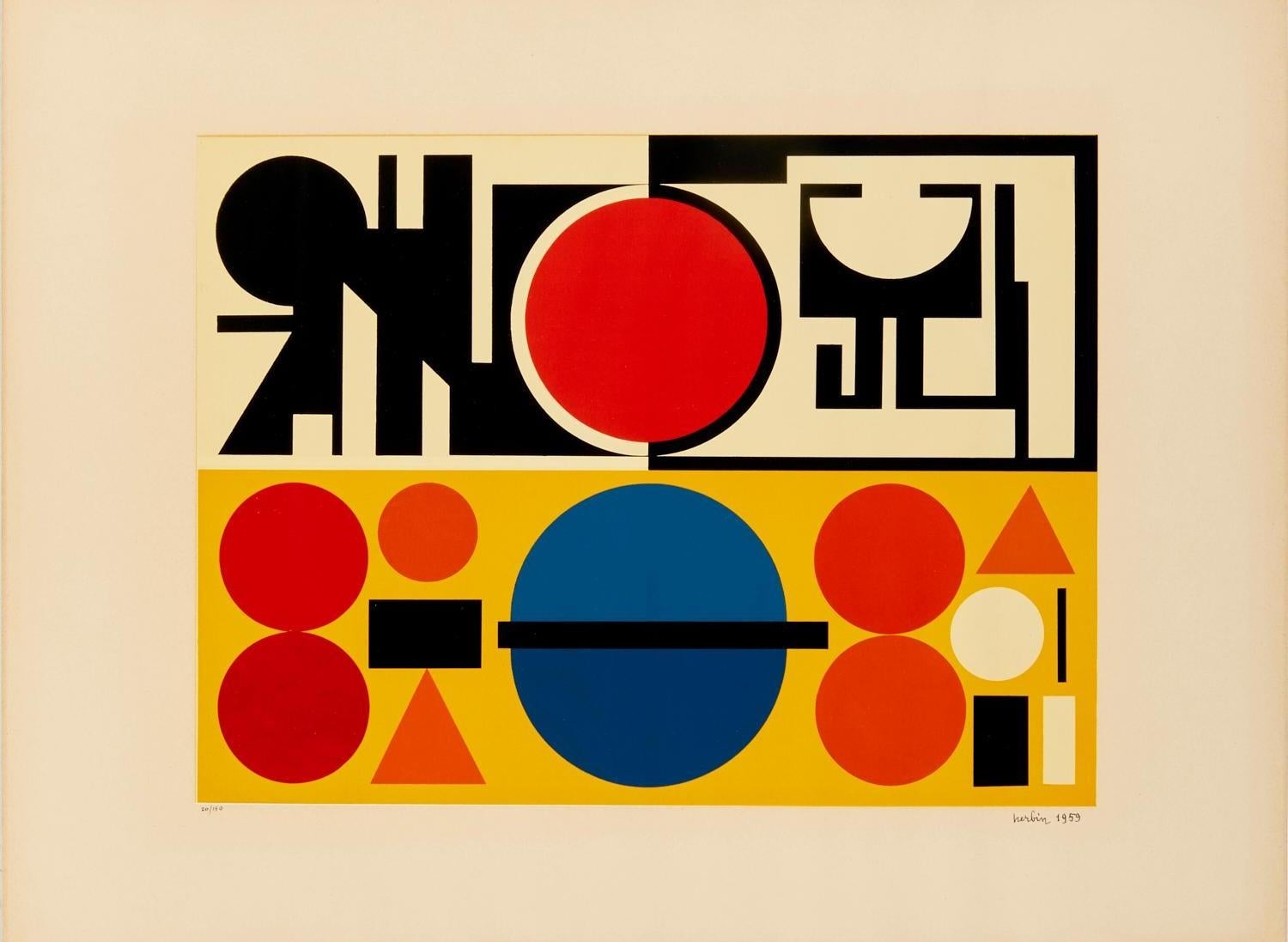Josef Albers'Interim' from the series 'Graphic Tectonics' —Mid-Century Geometric Abstraction1942
1942
About the Item
- Creator:Josef Albers (1888 - 1976, American, German)
- Creation Year:1942
- Dimensions:Height: 7.57 in (19.23 cm)Width: 15.19 in (38.59 cm)
- Medium:
- Movement & Style:
- Period:
- Condition:
- Gallery Location:Myrtle Beach, SC
- Reference Number:
Josef Albers
The German-born American painter, writer, and educator Josef Albers was a pioneer of 20th century modernism, and an innovative practitioner of color theory. With his wife, the textile artist and printmaker Anni Albers (1899–1994), he shaped the development of a generation of American artists and designers through his teaching at the experimental Black Mountain College in North Carolina, and later at Yale University School of Art, where he was the chairman of the department of design from 1950–1958. Albers is widely known for his series of prints and paintings "Homages to the Square," which he created between 1950 and 1975. His influential volume on color theory The Interaction of Color was published in 1963.
Albers was born in Bottrop, Germany, and as a young man he studied art education, earning certification from the Königliche Kunstschule in Berlin in 1915. He entered the legendary Bauhaus school in Weimar in 1920. The Bauhaus had been established by Walter Gropius in 1919, in the immediate aftermath of World War I, with the hope that its innovative curriculum would foster connections between architecture, art, and traditional crafts. In 1923 Albers began teaching the Vorkurs, the introductory class in which new students learned to work with each of the key artists’ materials, along with color theory, composition, construction and design.
Albers was a polymath, and the multidisciplinary environment of the Bauhaus was fertile ground for his artistic ambitions. When the school moved from Weimar to Dessau in 1925, he became a full professor, and in addition to glass and metal, he designed typefaces and furniture. While at the Bauhaus, Albers drew inspiration from the work of his colleagues, the color theorist Johannes Itten, and the painter, photographer, and designer László Moholy-Nagy, with whom he co-taught the Vorkurs.
In 1933, the Bauhaus was shut down due to pressure from the Nazi Party, which perceived the school as being sympathetic to communist intellectuals. As Albers’ wife Anni was Jewish, the couple resolved to leave Germany, and settled in rural North Carolina. The architect Philip Johnson helped make arrangements for Albers to join the faculty of Black Mountain College as the head of the painting program, where he remained until 1949. While at Black Mountain, both Josef and Anni Albers became influential mentors to American artists including Ruth Asawa, Cy Twombly, and Robert Rauschenberg, while working alongside fellow professors Buckminster Fuller, John Cage, Merce Cunningham and William de Kooning.
In 1950, Albers joined the faculty of the Yale University School of Art where he would head the newly established Department of Design until his retirement in 1958. In the 1950s, the Alberses began taking trips to Mexico, where the colors and forms of the local art and architecture inspired both artists.
In 1971, Albers became the first living artist whose work was the subject of a solo retrospective at the Metropolitan Museum of Art. Though they worked in different mediums, Josef and Anni Albers’ work shares a fascination with color and geometry. Josef Albers’ compositions from the "Homages to the Square" series, such as Formulation: Articulation Portfolio II Folder 28 (B), from 1972, give deceptively simple shapes a novel vibrance as colors play off of one another. The hues in Articulation Portfolio II Folder 28 (B) work in concert to give the flat surface the distinct appearance of a tunnel or other three-dimensional space; while the form on the left appears to move towards the viewer, the form on the right seems to lead directly into the canvas. Similarly, Anni Albers’ designs for textiles use graphic design to lend a sense of dynamism to flat works. Her Study for Unexecuted Wall Hanging (Bauhaus), from 1984 is a Mondrian-like pattern for a weaving in which different colors alternately recede and advance into the foreground, giving the image a sense of complexity and uncanny depth.
Josef Albers also created works of public art, including a delicate, geometric gold leaf mural called Two Structural Constellations for the lobby of the Corning Glass building in New York City in 1959. He designed a work called Two Portals for the lobby of the Time & Life Building in 1961, in which which and brown bands move towards two square panels made of bronze. Walter Gropius invited Albers to create a piece for the Pan Am Building, which he was designing with the architectural firm of Emery Roth & Sons. Albers reworked an existing glass piece from his Bauhaus days called City, and, fittingly, renamed it Manhattan.
Find a collection of authentic Josef Albers art on 1stDibs.
- ShippingRetrieving quote...Ships From: Myrtle Beach, SC
- Return PolicyA return for this item may be initiated within 7 days of delivery.
- Constructivist Abstraction — 1930s Spacial IllusionismBy Paul KelpeLocated in Myrtle Beach, SCPaul Kelpe, Untitled (Abstract Composition), lithograph, 1937, edition unknown but small. Signed and dated in pencil. A fine, richly-inked impression, with all the nuanced texture an...Category
1930s Abstract Geometric Abstract Prints
MaterialsLithograph
- Interlinear K50 — Mid-Century Geometric AbstractionBy Josef AlbersLocated in Myrtle Beach, SCJosef Albers, 'Interlinear K50', zinc plate lithograph offset to stone printing, 1962, edition 20, Danilowitz 151. Signed, titled, dated, and numbered '14/20' in pencil. A superb, ri...Category
1960s Abstract Geometric Abstract Prints
MaterialsLithograph
- 'Segments' — 1930s Geometric AbstractionBy Josef AlbersLocated in Myrtle Beach, SCJosef Albers, 'Segments', linoleum cut, 1934, edition 20, 25, plus proofs, Danilowitz 79. Signed, titled, dated, and annotated '(proof)' in pencil. A fine, richly-inked impression on...Category
1930s Abstract Geometric Abstract Prints
MaterialsLinocut
- Expressionist Abstraction — Hawaiian ArtistBy Tetsuo OchikuboLocated in Myrtle Beach, SCTetsuo "Bob" Ochikubo, 'Untitled (Abstract Expressionist Composition)', color lithograph, 1963, edition 3. Signed, dated, and numbered '3-3' in pencil. A fine, richly-inked impression, with fresh colors, on cream wove paper; the full sheet with margins (5/8 to 2 inches), in excellent condition. Very scarce. Image size 17 1/2 x 12 1/4 inches; sheet size 19 7/8 x 14 7/8 inches. Matted to museum standards, unframed. ABOUT THE ARTIST Tetsuo Ochikubo (1923–1975), also known as Bob Ochikubo, was a Japanese-American painter and printmaker who was born in Waipahu, Hawaii. After service in the US Army as an infantryman in Europe during World War II, Ochikubo studied painting and design at the School of the Art Institute of Chicago and the Art Students League in New York. He worked at the renowned lithography workshop Tamarind Institute in the 1960s and is best known for his non-objective paintings and lithographs. Ochikubo was a member of the Metcalf Chateau, a group of seven Asian-American artists with ties to Honolulu which included Satoru Abe...Category
1960s Abstract Abstract Prints
MaterialsLithograph
- 'Feu sous L'eau' (Fire Under Water) —Mid-century Modernism, Atelier 17By Stanley William HayterLocated in Myrtle Beach, SCStanley William Hayter, 'Feu sous L'eau (Fire Under Water)', color engraving, soft-ground etching and scorper with yellow silkscreen, 1955, edition 50 plus 10 artist proofs, Black & Moorhead 221. Signed, titled 'Fire Under Water', dated and annotated 'Essai' in pencil. Dedicated in the artist’s hand 'for Adja & Dove WH Bill 17–5–55' in the top margin. A superb, richly inked impression with fresh colors, on heavy, cream wove paper; wide margins (2 1/2 to 3 7/8 inches), in excellent condition. One of 10 artist’s proofs. Image size 10 3/16 x 7 inches; sheet size 18 1/8 x 12 1/4 inches. Matted to museum standards, unframed. ABOUT THIS WORK In 1950 Hayter returned to Paris and reopened Atelier 17. Works such as 'Fire Under Water' reveal newfound influences, such as that of the Ardèche area of southern France, where he acquired a house in 1951 and frequently visited. Hayter took great interest in the flowing Escoutay River, an experience that parallels the artist and co-director of Atelier 17 Krishna Reddy’s interest in depicting water. While some forms in this print evoke the natural world, the palette of contrasting tones of purple, yellow, black, and white reflects Hayter’s belief in using color intuitively to express emotions and evoke feelings. The sharp white relief lines from the paper and the textural effects realized through soft-ground etching operate in tandem with the sweeping curves and bold colors to give the composition a sense of vitality and dynamism. —edited from the Metropolitan Museum of Art Published by 'La Jeune Gravure Contemporaine', Paris. Impressions of this work are in the following collections: British Museum, Metropolitan Museum of Art, National Gallery of Art. ABOUT THE ARTIST Stanley William Hayter (1901-1988) was a British painter and printmaker associated in the 1930s with Surrealism and from 1940 onward with Abstract Expressionism. Regarded as one of the most significant printmakers of the 20th century, Hayter founded the legendary Atelier 17 studio in Paris, now known as Atelier Contrepoint. Among the artists he is credited with influencing are Pablo Picasso, Alberto Giacometti, Joan Miró, Alexander Calder, and Marc Chagall. The hallmark of the workshop was its egalitarian structure, breaking sharply with the traditional French engraving studios by insisting on a cooperative approach to labor and technical discoveries. In 1929 Hayter was introduced to Surrealism by Yves Tanguy and André Masson, who, with other Surrealists, worked with Hayter at Atelier 17. The often violent imagery of Hayter’s Surrealist period was stimulated in part by his passionate response to the Spanish Civil War and the rise of Fascism. He organized portfolios of graphic works to raise funds for the Spanish cause, including Solidarité (Paris, 1938), a portfolio of seven prints, one of them by Picasso. Hayter frequently exhibited with the Surrealists during the 1930s but left the movement when Paul Eluard was expelled. Eluard’s poem Facile Proie (1939) was written in response to a set of Hayter’s engravings. Other writers with whom Hayter collaborated included Samuel Beckett and Georges Hugnet. Hayter joined the exile of the Parisian avant-garde in 1939, moving with his second wife, the American sculptor Helen Phillips...Category
1950s Abstract Expressionist Abstract Prints
MaterialsEngraving, Etching
- 'Arrangement with Blue Major' — Mid-Century AbstractionBy Edward August LandonLocated in Myrtle Beach, SCEdward Landon, 'Arrangement with Blue Major', color serigraph, edition 40, 1942, Ryan 9. Signed, titled, and annotated 'Edition 40' in pencil. A superb impression, with fresh colors, on cream, wove paper; the full sheet with margins (3/4 to 1 5/8 inches), in excellent condition. Image size 15 x 9 3/4 inches (381 x 248 mm); sheet size 17 15/16 x 11 3/4 inches (456 x 298 mm). Matted to museum standards, unframed. 'Arrangement with Blue Major' was selected for the landmark ‘Artists for Victory’ exhibition at the Metropolitan Museum of Art in 1942. Impressions of this work are also in the collections of the Asheville Art Museum, Five Colleges and Historic Deerfield Museum Consortium, Georgetown University (Special Collections), Mount Holyoke College Art Museum, Rutgers University, Smith College Museum of Art, and the Springfield Museum of Fine Arts. ABOUT THE ARTIST Born in Hartford, Connecticut, Edward Landon dropped out of high school to study art at the Hartford Art School. In 1930 and 1931, he was a student of Jean Charlot at the Art Students League in New York, after which he traveled to Mexico to study privately for a year with Carlos Merida. In 1933 he settled near Springfield, Massachusetts, painted murals in the local trade school, and exhibited with the Springfield Art League. His painting 'Memorial Day' won first prize at the fifteenth annual exhibition of the League at the Springfield Museum of Fine Arts. Landon became an active member of the Artists Union of Western Massachusetts, serving as president from 1934-1938. Landon acquired Anthony Velonis’s instructional pamphlet on the technique of serigraphy in the late 1930s. With colleagues Phillip Hicken, Donald Reichert, and Pauline Stiriss, he began experimenting with screen printing techniques. The artists' groundbreaking work in screen printing as a fine art medium was the subject of the group’s landmark exhibition at the Springfield Museum of Fine Arts in 1940. Landon became one of the founding members of the National Serigraph Society and served as editor of its publication, 'Serigraph Quarterly,' in the late 1940s and as its president in 1952 and 1953. The Norlyst Gallery in Manhattan held a one-person show of his prints in 1945. Awarded a Fulbright Fellowship in 1950, Landon traveled to Norway, where he researched the history of local artistic traditions and produced the book 'Scandinavian Design: Picture and Rune Stones...Category
Mid-20th Century Abstract Abstract Prints
MaterialsScreen
- AlchimiesBy Julio Le ParcLocated in LILLE, FRSigned and numbered art print by Julio Le Parc including all the "ALCHIMIES" drawn for its artists book "Petite bifurcation de celui qui n'est pas" published by Editions Sylvain Cour...Category
2010s Abstract Geometric Abstract Prints
MaterialsLithograph
- La Vague (The Wave)By Alexander CalderLocated in Ljubljana, SILa Vague (The Wave). Original color lithograph, 1971. Edition of 100 signed and numbered impressions on Arches paper. Alexander Calder is one of the most important kinetic artist form America. Although primarily known for his sculpture, he also created paintings and prints, miniatures, theater set design, jewelry design, tapestries, rugs, and political posters. “My whole theory about art is the disparity that exists between form, masses, and movement.” He named much of his work in French, like this one, regardless of where they were meant to be displayed. In the 1930. Calder visited Piet Mondrian’s studio, after which he seeks influence in Mondrian’s colors and geometry in Calder’s artwork...Category
1970s Abstract Geometric Abstract Prints
MaterialsLithograph
- Outside BlankBy Shusaku ArakawaLocated in Henderson, NVArakawa made an impact on the New York art world during the 1980s.Category
1980s Abstract Geometric Abstract Prints
MaterialsPaper, Lithograph
- Four season winterBy Karl MomenLocated in West Palm Beach, FLHand signed and numbered lithograph Momen has made a small collection of lithographs in full colours, for these under painting of his large f...Category
21st Century and Contemporary Abstract Geometric Abstract Prints
MaterialsLithograph
- BetelgeuseBy Victor VasarelyLocated in Miami, FLSigned and numbered limited edition screenprint on paper Series Betelgeuse, "Black and White Dots" Artist signature and hand numbered 43 of 150 to bottom. Presented in modern custo...Category
1970s Abstract Geometric Abstract Prints
MaterialsLithograph
- Untitled (Geometric Composition), 1957By Auguste HerbinLocated in Miami, FLUntitled (Geometric Composition), 1957 - After the painting "Orphée" by Auguste Herbin 70 x 50 cm Color serigraph on strong wove paper. Signed, dated and numbered, edition of 100 ...Category
1950s Abstract Geometric Abstract Prints
MaterialsLithograph






